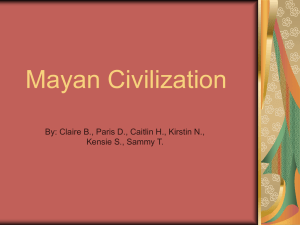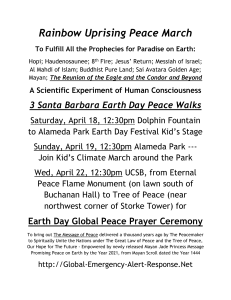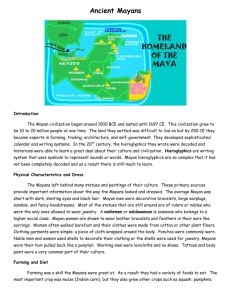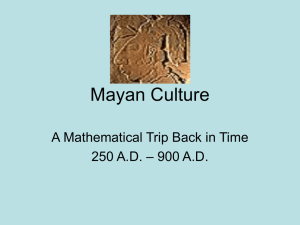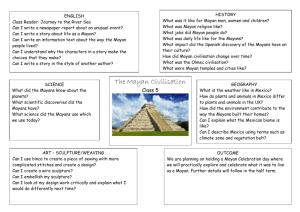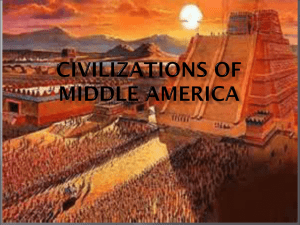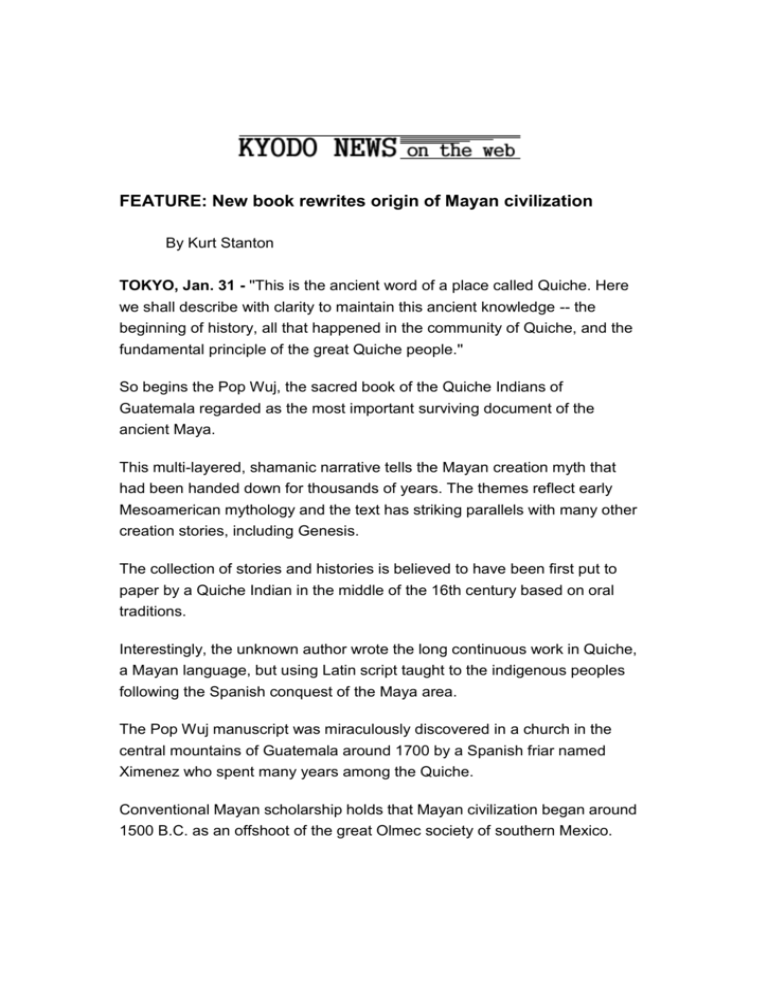
FEATURE: New book rewrites origin of Mayan civilization
By Kurt Stanton
TOKYO, Jan. 31 - ''This is the ancient word of a place called Quiche. Here
we shall describe with clarity to maintain this ancient knowledge -- the
beginning of history, all that happened in the community of Quiche, and the
fundamental principle of the great Quiche people.''
So begins the Pop Wuj, the sacred book of the Quiche Indians of
Guatemala regarded as the most important surviving document of the
ancient Maya.
This multi-layered, shamanic narrative tells the Mayan creation myth that
had been handed down for thousands of years. The themes reflect early
Mesoamerican mythology and the text has striking parallels with many other
creation stories, including Genesis.
The collection of stories and histories is believed to have been first put to
paper by a Quiche Indian in the middle of the 16th century based on oral
traditions.
Interestingly, the unknown author wrote the long continuous work in Quiche,
a Mayan language, but using Latin script taught to the indigenous peoples
following the Spanish conquest of the Maya area.
The Pop Wuj manuscript was miraculously discovered in a church in the
central mountains of Guatemala around 1700 by a Spanish friar named
Ximenez who spent many years among the Quiche.
Conventional Mayan scholarship holds that Mayan civilization began around
1500 B.C. as an offshoot of the great Olmec society of southern Mexico.
However, a Maya-Quiche philosopher named Victoriano Alvarez Juarez
who has spent most of his life deciphering the Pop Wuj in the original
Quiche has advanced an entirely new hypothesis about the origin of the
Maya.
This hypothesis is explained in detail in a new book by Japanese Mayanist
Katsuyoshi Sanematsu. ''A New Vision of Mayan Civilization -- Deciphering
of the Ancient Myth Pop Wuj,'' published by Kodansha Ltd., is based on
extensive research the author conducted in Guatemala with Juarez, 76.
Sanemtasu, 54, a professor at Rikkyo University (St. Paul's University) in
Tokyo, told Kyodo News in a recent interview that this reconstruction of
Mayan history has been made possible by a fresh interpretation of the Pop
Wuj, also called the Popol Vuh.
His book, which is dedicated to the Guatemala Mayans, marks the first time
for Juarez's theory to appear in print. ''It is an interpretation of Mayan
civilization based on the concepts of Mayans themselves,'' Sanematsu said.
''These are not the ideas of a Japanese, European or American. This to me
is very important.''
Juarez, says Sanematsu, has come to the conclusion that the sacred text
documents ancient Mayan history using mythological and symbolic
language.
According to the new theory, the original Mayan civilization has a much
older origin than today's Mayanists, archeologists or anthropologists
assume, beginning more than 5,000 years ago on the Pacific coast of
Guatemala. Later on, this original civilization split up and eventually
spawned such civilizations as the Olmec, Teotihuacan, Toltec, and
Pre-classic and Classic Maya.
One of the amazing conclusions of the new theory is that the so-called Maya
Classic Period (A.D. 200-900) traditionally designating the high-water mark
of Mayan culture was in fact a time of decline.
The conventional view cites the huge city states, soaring temple pyramids,
elaborate monuments, refined Mayan glyphs and stunning paintings of this
period.
According to Sanematsu, the new theory, on the contrary, views this period
as a time of stagnation and decadence marked by incessant warfare, the
revival of human sacrifice and the spread of sorcery.
This interpretation resolves a contradiction that has troubled scholars for
years, namely, how the Mayans could carry out such inhuman practices
despite living during what is conventionally considered their zenith of
knowledge and artistic expression.
The ancient Mayans, by contrast, had an extremely strong sense of
humanity, Sanematsu says. ''But it wasn't something given by the gods, but
rather hard won through the struggle against tyranny and ignorance (prior to
the dawn of the original Mayan civilization).''
Juarez contends that Mayan civilization was actually built by mixed groups
of people forming what he calls the Maya-Toltec civilization. This
proto-Maya civilization, which began on Aug. 13, 3114 B.C., achieved
stunning results in various fields.
In astronomy, for example, they were able to calculate the length of the
solar year to an accuracy rivaling today's measurements (365.2420 days of
the Mayan calendar versus the modern 365.2422 days).
Moreover, there is evidence that they even knew the precise location of our
solar system in the Milky Way.
However, their greatest achievements were spiritual in nature. The early
Mayans had a thirst for knowledge and little interest in materialistic
development.
Instead, they directed most of their energy to establishing a unique system
of knowledge integrating the universe and life. Juarez calls this ''Mayan
science,'' while noting that their concept of science encompassed a much
larger scope than in the West, involving such areas as society, religion and
ethics.
Finally, the ancient Mayans expressed this system of knowledge in a unique
form known as the sacred Mayan calendar. This calendar comprises 260
days divided into 13 cycles of 20 ''day spirits.''
Unfortunately, the original Mayan civilization eventually succumbed to
various internal and external pressures, with its great spiritual traditions
completely forgotten by the time the Classic Period began around A.D. 200.
All of these and other conclusions have been drawn by deciphering the Pop
Wuj based on a critical understanding of living traditions, according to
Sanematsu.
Many of the conclusions are entirely new, opposed to the conventional view
of Mayan civilization, and therefore bound to stir controversy.
Sanematsu believes that while further research and discussion of the
conclusions is necessary, the new hypothesis is valid and sheds light on
many unsolved mysteries about the Maya and Mesoamerican histories.
January 31, 2003 20:23:01
2002 Kyodo News (c) Established 1945.
All Rights Reserved


